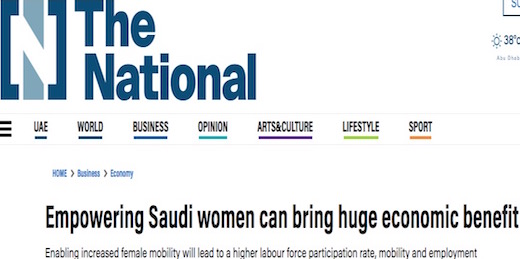The article titled “Empowering Saudi women can bring huge economic benefit”, appeared in The National’s print edition on 4th Oct, 2017 and is posted below. Click here to access the original article.
Saudi Arabia’s historic decision to allow women to drive is a watershed moment in the kingdom’s history as it presses on with its reform agenda. It signals a clear determination and political will to undertake deep socio-cultural reforms and overcome conservative forces, including the clerical establishment, which have dominated everyday life in the kingdom and prevented the modernisation of economy and society. The liberalisation of women is a key plank of the modernisation objectives set out in the ambitious Vision 2030 and National Transformation Programme explicitly intended to “Empower women and materialise their potential”.
Allowing women to drive increases women’s happiness and well-being, sending an important signal of a deep reform agenda. But what are the prospective, tangible benefits? Enabling increased female mobility will lead to a higher labour force participation rate, labour mobility and employment of females. Currently, women’s participation in the workforce is merely 20.1 per cent and represents only 18 per cent of the female working age population. The youth (15-24 year olds) unemployment rate is 31.2 per cent, while the female youth unemployment rate is a staggering 58.1 per cent, despite Saudi female educational attainment exceeding that of males. The human capital embodied in Saudi females is being wasted.
Higher labour participation and employment means higher national income which will translate into higher consumer spending, including on cars, insurance and transportation, and providing an additional spending stimulus in advance of the introduction of VAT in January 2018. The reform will also encourage women to set up, own and run their own businesses, encouraging female entrepreneurs and bolstering job creation in SMEs. It will boost the services sector in which women have a comparative advantage, supporting the strategy of economic diversification.
However, women in Saudi face multiple barriers to realising their legal, social and economic potential, which include regulations and associated restrictions on travel, access to finance, unequal property and inheritance rights.
This low status of women is not a phenomenon unique to Saudi Arabia, it characterises much of the Arab world. Arab women have the lowest labour force participation rate (LFPR), only 22.6 per cent, of any global region and the largest gap with men’s participation and earnings. The poor performance is largely due to multiple barriers to entry ranging from “protective” labour laws to a lack of access to finance; women do not have equal access to collateral, such as land and real estate, to back financial loans.
The World Bank’s survey on Women, Business & the Law 2016 finds that the Arab economies have 10 or more legal biases on women’s work, which have a negative impact on women’s economic participation, entrepreneurship and earnings potential relative to men. As a consequence, the Arab region has the lowest overall LFPR: only 49.9 per cent compared to a world rate of 62.8 per cent, negatively affecting performance and prospects.
More generally, the Arab region continues to rank last globally on the gender gaps across all the health, education, economy and political dimensions. Women face insuperable barriers, discrimination, legal and regulatory hurdles, lack of economic opportunities, poor working conditions and the absence of the institutional and societal support needed to leverage them into economic and public life.
Absent deep and sustained reforms, closing the gender gaps would take 129 years. But if female LFPRs could be raised to the same level as in the OECD (60 per cent), the Arab countries could increase GDP by 20 to 25 per cent. A recent McKinsey study found that full gender parity could contribute US$2.7 trillion to regional GDP by 2025, or $600 billion per year; this could mean a staggering increase of regional GDP by 47 per cent in a decade.
We need a paradigm shift, a transformation of women’s roles in economic development and their empowerment. Policies should address the combined influence of social norms and beliefs, women’s access to economic opportunities, the legal framework and women’s education. To enable this shift, women need to be well represented across the economic, social and political arenas to bring about real change in economic growth, productivity and social well-being.
Making greater use of women workers increases growth and productivity, not only because women jobseekers typically have higher than average education, but also because this can increase mobility across sectors and jobs. Economic performance, innovation, creativity and the economic landscape of the Arab world would be transformed through the contribution of the skills, talent, labour and entrepreneurship of women. While economic development helps to bring about women’s empowerment, empowering women brings about changes in choices and decision-making, which have a direct, positive impact.
Empowering women and moving towards gender equality is just smart economics; it is time the Arab world accepts this fact and works to meet this goal. The region has a long way to go: the priority should be for an affirmative action programme that actively promotes women and reverses marginalisation and discrimination.






